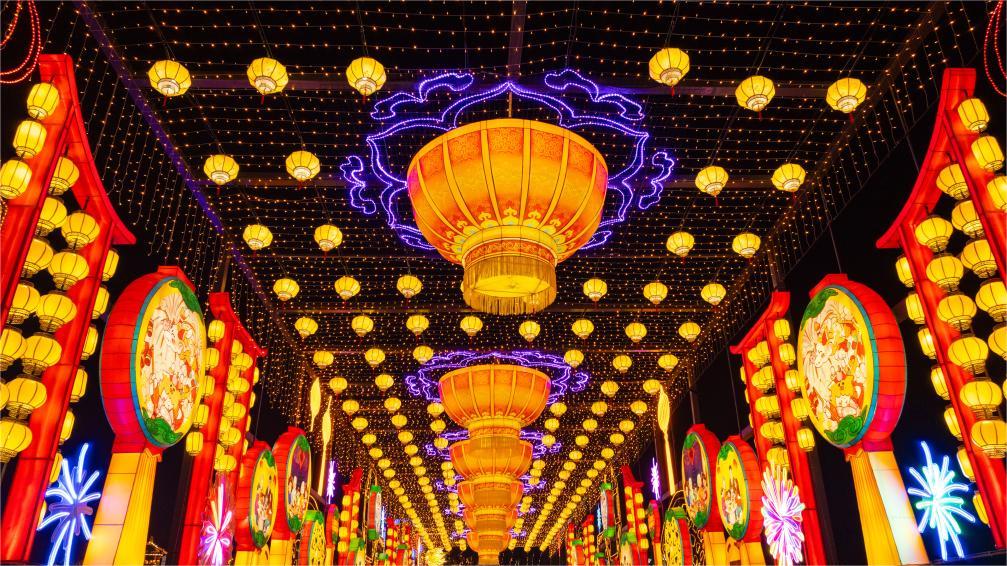Ethnic tourism invigorates northeast China border region
CHANGCHUN, Jan. 29 (Xinhua) -- Yanbian, the only autonomous prefecture of China's Korean ethnic group, has witnessed an influx of tourists visiting its unique ethnic cultural experiences this winter.
More than thrilled to kickstart their long-anticipated trip, Hu Kangjie and his family from the tropical island province of Hainan, traveled more than 4,000 km to visit the prefecture in northeast China's Jilin Province.
"Here we not only can get a close look at the winter scenery and local customs in northeastern China, but we can also experience the Korean folklore. It's a combination of tradition and fashion, and boasts mouth-watering delicacies," said Hu.
Situated in the east of Jilin Province, Yanbian Korean Autonomous Prefecture, where 742,000 ethnic Koreans call home, is bordered by Russia in the east, and is separated by the Tumen River from the Democratic People's Republic of Korea.
Donning traditional Korean ethnic costumes, Hu, his wife and daughter posed for photos inside a folklore culture theme park as well as experienced a culinary delight by making glutinous rice cake, a traditional and popular Korean ethnic dessert.
"My daughter not only had great fun, but also learned about the local ethnic culture. The trip was worth it," Hu said.
The 9.4-hectare folk park, which the family had visited, received a whopping 3.17 million visitors in 2023. Even in winter, the tourism off-season, it still welcomes 10,000 visitors on average per day.
"We develop tourism products with our own characteristics," said Zhu Baokun, chief operating officer of the park. "For example, during the lantern festival held at the park this winter, we infused elements from the traditional Korean ethnic culture and Jilin's iconic rime into the design of the lanterns, and these interactive installations have created a much better experience for visitors."
Yanji, the prefecture's capital, has risen into a tourist mecca in recent years, partly associated with the prominence of "citywalk." Literally referring to roaming around the city on foot, citywalk echoes a shift in the way young urban travellers explore a new place -- they want something offbeat, down-to-earth, and a personalized memory.
Boasting a distinct and famed culinary culture, Yanbian quickly captured youngsters' attention. Posts hashtagged Yanbian featuring day trippers indulging in local delicacies drew huge online discussions, luring more curious travelers to enjoy a bite of the authentic Korean-style food.
Official data shows Yanbian welcomed over 26 million domestic tourists last year, with its generated revenue estimated at 43.47 billion yuan (about 6 billion U.S. dollars).
GUESTS FROM AFAR
Hunchun, a border city in Yanbian, has also witnessed a tourism boom.
Early January, Alexander Protasov, from Vladivostok, Russia, visited Hunchun twice a week with his family.
"Here in Hunchun we can see a lot of Russian elements, and the children love the new amusement park. We like to come here to buy things, eat delicious food, enjoy hot springs and get massages," Protasov said, adding many restaurants, shopping centers and entertainment venues in Hunchun present a variety of activities and menus tailored for Russian tourists during the holiday.
According to data from the entry and exit checkpoint in Hunchun, more than 230,000 Russian tourists passed through the checkpoint in 2023 and this year, the number has surpassed 18,000.
The younger generation, who opted for a career in the first and second-tier cities, are also coming as they see tremendous economic potential in Hunchun.
Yang Lina was among the first to come back. Apart from running a Korean-style homestay, she also operates a popular cultural tourism project.
She later set her sight on Naitoushan, a village just 18 km away from the famous Changbai Mountain, bullish on the burgeoning ice-and-snow tourism in China.
Centering on its superior ice and snow resources, the village receives an average annual tourist arrival of more than 400,000, attracting floods of visitors and a growing number of young entrepreneurs alike.
"We were so jolly. Here we played rafting and went for a horse-drawn sleigh ride. It's like a paradise, especially suitable for slowing down and enjoying the charm of the Korean-style small village," said Fu Ying, a tourist from Jiangxi Province in eastern China.
This winter, Yang's hot spring resort hotel project in the village is ready to greet the sightseers. She is currently busy upgrading some other winter tourism projects.
"Our border region is getting better and more attractive, and we need to keep learning and exploring to turn the 'traffic' into 'profit'," Yang added.
Photos
 In pics: light installations for 30th Int'l Dinosaur Lantern Show in Zigong, SW China
In pics: light installations for 30th Int'l Dinosaur Lantern Show in Zigong, SW China Snow scenery at section of Wushan Mountain in China's Chongqing
Snow scenery at section of Wushan Mountain in China's Chongqing Pic story: young entrepreneur contributes to scientific visualization in China's Anhui
Pic story: young entrepreneur contributes to scientific visualization in China's Anhui Breathtaking 'blue tears' light up coastal waters in China's Guangdong
Breathtaking 'blue tears' light up coastal waters in China's Guangdong
Related Stories
Copyright © 2024 People's Daily Online. All Rights Reserved.





